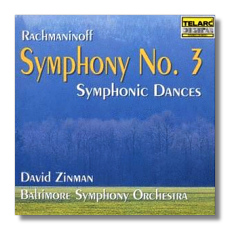
The Internet's Premier Classical Music Source
Related Links
- Rachmaninoff Reviews
- Latest Reviews
- More Reviews
-
By Composer
-
Collections
DVD & Blu-ray
Books
Concert Reviews
Articles/Interviews
Software
Audio
Search Amazon
Recommended Links
Site News
 CD Review
CD Review
Sergei Rachmaninoff

- Symphony #3 in A minor, Op. 44 (1936)
- Symphonic Dances Op. 45 (1940)
Baltimore Symphony Orchestra/David Zinman
Telarc 80331 74min
When Don Vroon reviewed Zinman's Telarc recording of Rachmaninoff's Symphony 2 in the September/October 1992 American Record Guide, he noted that the conductor "seems too afraid of sentimentality to let the music express itself emotionally." Whether Zinman has matured as an interpreter in the intervening time or he simply feels a greater affinity for Rachmaninoff's 3rd, there is no lack of emotional expression here. Indeed, one would have to look back to Stokowski or Koussevitzky to find a more deeply felt reading of this vastly underrated masterpiece. From the bittersweet nostalgia for old Russia of the cello theme in I to the martial spirit of the scherzo that Rachmaninoff embedded in the midst of the adagio second movement, Zinman effortlessly conveys the shifting moods and colors of the score. He allows his string players to indulge in copious amounts of old-fashioned portamento, with magical results. While Zinman obviously revels in the melodic splendor of this score - and even Previn on EMI can't match the unique vocal quality of his phrasing - he's also adept at conveying its titanic drama and intense passions. To cite just one example, he builds the development of I to a spectacularly tense climax of Mahlerian proportions, after which the return of the Orthodox chant-like main theme serves as a poignant reminder of a past that is now tragically lost to us forever. Cary Smith credited Zinman for the Baltimore Symphony's "polish, clarity, and precision" in his analysis of the ensemble which appeared in ARG's November/December 1994 issue. Those characteristics are all readily apparent here. Indeed, with its enchanting solo winds, soaring violins, and a cello section that boasts all the soulfulness and resonance of a fine Russian male chorus, this orchestra - at least on the evidence of this recording - sounds as good as any in the country today.
Don Vroon's reservations about Zinman do come to mind when listening to him conduct the Symphonic Dances. After a truly arresting beginning, he settles down into a routine and unexciting reading of I. The glorious saxophone solo is taken rather too quickly, and it's played with too much vibrato. As in the Symphony, Zinman doesn't hesitate to employ a bit of string portamento (at 5:21 in I, for example), and that is certainly welcome here. Nonetheless, Previn is more alert and exciting in the outer sections, while he makes the pastoral music in between sound utterly enchanting. Previn also makes a stronger impression in II thanks to the London Symphony's bright, brash trumpets and his relaxed pace (9:41 compared to Zinman's breezy 8:45). While Zinman hardly plumbs the emotional depths of Rachmaninoff's quirky waltz, his orchestra once again plays magnificently, and the graceful winds weave a delightful spell in spite of their conductor's lack of charm. Zinman rouses himself for a lively, outgoing, and intermittently thrilling finale. The cellos present the Dies Irae theme at 3:40 with the same glowing warmth, richness, and purity of tone that made their efforts in the Symphony so memorable. I also like Zinman's brisk and smartly accented coda, but, despite Telarc's generally satisfying sonics, the percussion simply doesn't have the impact of Previn's, and no one has equalled that phenomenal gong stroke at the very end of his recording.
While Zinman is clearly no match for Previn in the Dances, his breathtaking recording of the Symphony is well worth having - if for no other reason than to revel in the glorious sound of those Baltimore Symphony cellos!
Copyright © 1996, Thomas Godell




















